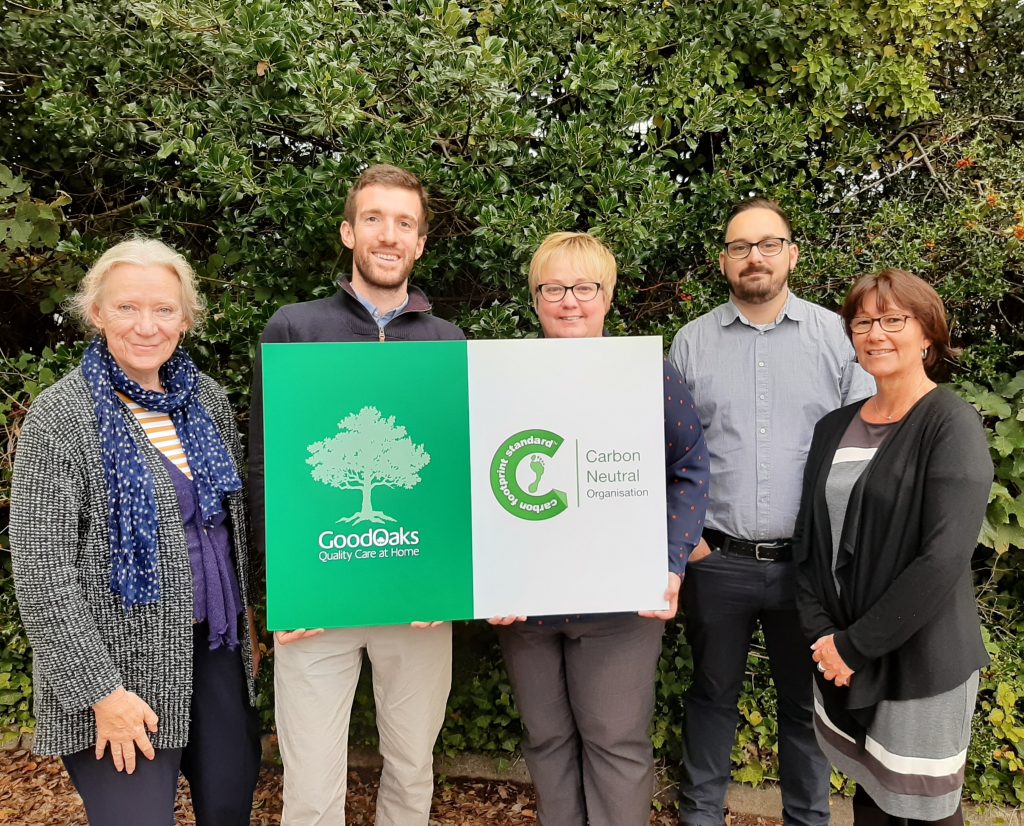Poole-based Good Oaks Home Care has become one of the first home care companies in the UK to become carbon neutral. The company has gained the Carbon Footprint Standard accreditation following an audit of its carbon emissions.
Good Oaks worked with the team at Carbon Footprint to calculate its carbon emissions across all four of its offices based in Dorset, Hampshire, Reading and Mid Sussex. Carbon Footprint evaluated the emissions that Good Oaks recorded and identified recommendations for reducing these.
Good Oaks chose to offset all unavoidable carbon emissions by investing in Carbon Footprint Ltd.’s carbon offset projects. Good Oaks’ Poole office, the company’s largest office with over 100 employees, was responsible for the majority of carbon emissions. These will be offset via a tree-planting scheme in the South West, which plants trees at schools and other bio-diversity sites. The planting will take place in the Autumn.
The majority of the company’s emissions were generated by carers travelling by car to provide care at clients’ homes. The other significant source of emissions was electricity consumption across the four sites.
Co-Founder of Good Oaks, Ben Ashton, said: “Becoming carbon neutral was an important investment for us to make. We didn’t want to wait for legislation to make this compulsory for smaller businesses. It is essential that other home care companies across the UK follow our lead, to calculate, reduce and offset their carbon emissions. As far as we know, we’re the only home care provider to have this accreditation and this needs to change.
“Due to the nature of the service we provide, helping support vulnerable people in their own homes, our carers currently need to use their cars to get between visits. Electric vehicles aren’t an affordable option yet and we needed to take action to reduce the impact of our carbon emissions now. Offsetting is just part of our long-term environmental strategy which will see us work hard to reduce our impact on the environment wherever we can. When our contract ends with our current energy supplier, we will also ensure our electricity is provided by 100% renewable energy.”
Carbon Footprint’s tree-planting project ensures that all trees planted are native, broad leaf species that help to preserve the UK’s biodiversity. For every tree that is planted, Good Oaks’ investment will also save one tree from being cut down in the Brazilian Amazon via Carbon Footprint’s avoided deforestation programme in South America.
The carbon emissions from Good Oaks’ three other offices will be offset by investment in solar power in one of Carbon Footprint’s projects in the states of Tamil Nadu and Telangana in India. The project develops renewable energy generation plants based on Solar PV technology to deliver electricity to the grid.
Dr. Wendy Buckley, Client Director at Carbon Footprint Ltd, said: “Good Oaks has taken a leading position by assessing the carbon impact of its business – even though there is no legislative requirement for them to do this. By offsetting unavoidable emissions, they are assuring that the service they deliver to their customers is sustainable and projects support communities both near and far.”
The Good Oaks team used Carbon Footprint’s online carbon calculator to calculate the company’s carbon footprint, for the period 1 July 2018 to 30 June 2019. The calculation uses the 2018 metrics developed by the Department for Business, Energy & Industrial Strategy (BEIS) for reporting GHG emissions.
The carbon footprint assessment includes:
- Building electricity consumption
- Car travel
- Bus and rail travel
A Carbon offset is a way to compensate for emissions by funding an equivalent carbon dioxide saving elsewhere. Everyday actions consume energy and produce carbon emissions, such as driving, flying and heating buildings. Carbon offsetting is used to balance out these emissions by helping to pay for emission savings in other parts of the world.
Planting trees removes carbon emissions when trees absorb carbon dioxide to produce oxygen and wood by photosynthesis.
